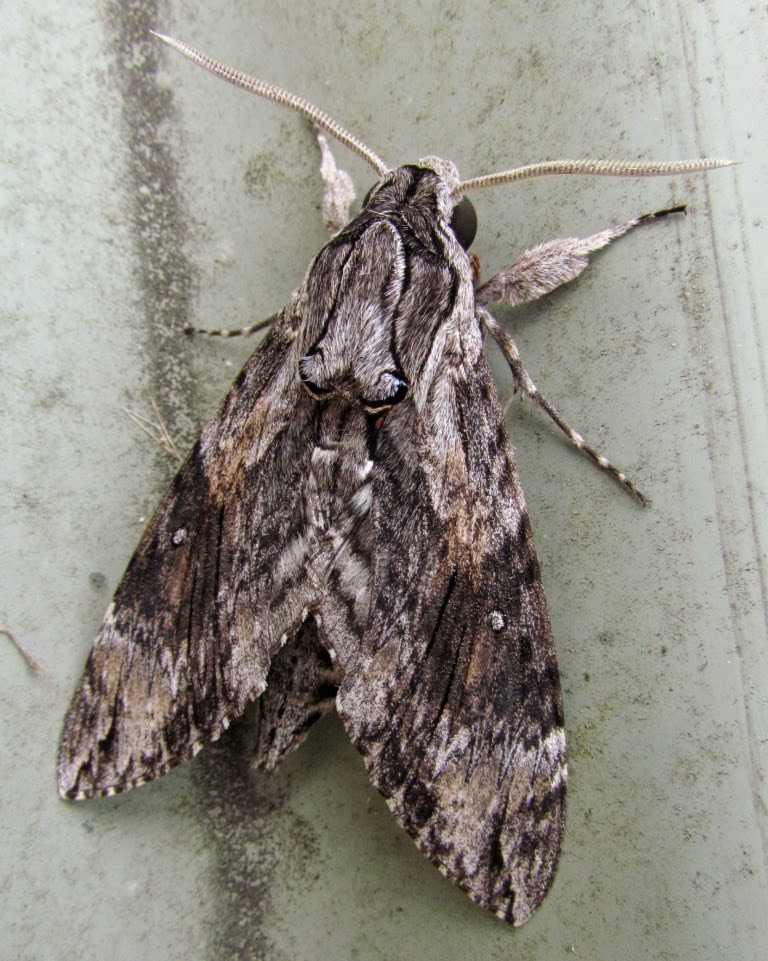We have Kookaburras with a nest hole in a termite nest, high in an ironbark eucalyptus and their young are busy calling for food deliveries.
I have been trying to get a photo of a delivery but the adult kookas will not go to the nest if they spot any potential threat. Without a hide I am obvious and that says maybe I am a threat so the adults will wait nearby until I depart before making a delivery.
I did manage to get a photo today with an adult about to deliver a large stick insect as the meal for the young.
Not wanting to delay deliveries, I don't visit the site often but keep a distant watch on the nest, listening to the young calling. The biggest threat is from the lace monitors, if they can get to the nest without being detected by the adults. If seen the adults will attack and generally drive the lizard off.
Saturday 27 December 2014
Saturday 20 December 2014
Morning Glory Hawk Moth
Yesterday I found this large moth resting on a window frame and had the opportunity to take a few photos before it had had enough and flew to a more appropriate spot in a eucalyptus.
The distinctive pink and black stripes on the body made identification as a Convolvulus Hawk Moth Agrius convolvuli quite simple.
The food source for its caterpillars are plants in the Convolulus family which include sweet potatoes where farmers regard it as a pest and Morning Glory vine which in our area is a weed of significance. On balance as we don't have too many sweet potato farms around we would like more of these moths to help us control the Morning Glory in the bushland.
Monday 15 December 2014
Calling Ms Peron
A distinctive long reverberating call from the pond outside the office last night had to be checked out to see if I had identified the maker of the noise.
Sure enough there was a Peron's Tree Frog Litoria peronii sitting on the floating azolla fern, calling to try and get a mate to join in the activity.
No sign of success this morning as the pond is bare of any egg mass.
The recent rain has increased the frog activity so I expect to get some more frog sightings whilst the vegetation has plenty of moisture. I can hear a couple of Dwarf Tee Frogs outside as I do this blog.
Sure enough there was a Peron's Tree Frog Litoria peronii sitting on the floating azolla fern, calling to try and get a mate to join in the activity.
No sign of success this morning as the pond is bare of any egg mass.
The recent rain has increased the frog activity so I expect to get some more frog sightings whilst the vegetation has plenty of moisture. I can hear a couple of Dwarf Tee Frogs outside as I do this blog.
Tuesday 9 December 2014
Grounded Redeye
Cicadas are getting into full song as we move into summer and I found one that had been blown out of a treetop and was finding some difficulty moving through the grass.
After the photo I placed it on a higher vantage point from which it promptly took to the air, however with many predators around such as Pacific Bazas it is a dangerous time whether in the air or on the ground.
Not hard to identify as a Redeye Cicada (f) Psaltoda moerens a species found down the east coast states with populations also scattered through Victoria and as Far as Adelaide.
Sunday 7 December 2014
Crested crown
A Pacific Baza Aviceda subcristata or its other common name Crested Hawk perched in one of the iron bark eucalyptus to finish off the Cicada it had just caught.
Large insects such as Christmas Beetles, Stick Insects and Cicadas together with small birds and frogs are the prey, so the hawk hunts through the treetops.
There are a number of Bazas world wide but the Pacific Baza is found from the Malay peninsular, Indonesia, Papua New Guinea and north eastern Australia. The prominent crest is a feature of the Bazas.
A couple of days after the first photo I saw this bird come over the treetops then quickly climb and I had one quick chance for the photo before it disappeared behind the trees. It was quite high so the photo is not great but enough for identification as a Pacific Baza.
Wednesday 3 December 2014
Christmas is not far away
One of my childhood indicators that said Christmas was just around the corner was the appearance of Christmas Beetles.
There are 34 species of Christmas beetle (Anoplognathus species) members of
the family Scarabaeidae and they are distributed throughout Australia,
although most species occur in the higher rainfall areas of the southern and
eastern states. Their colouring ranges through shades of brown, green, iridescent green and brown with green iridescence as in the one I photographed. It is the usual one found in our are and is the most common Anoplognathus porosus and the main one of my childhood memories.
The larvae are large whitish grubs with a distinctive C shape hence the name "curl grubs" and are found in the soil of grassland, woodland and suburban gardens. At times their emergence as beetles can be in such large numbers that they can defoliate eucalyptus trees, that are their food source.
In the bright sun I found it difficult to show the iridescent green, so my shadow provided the shade to highlight the colours.
Subscribe to:
Posts (Atom)











